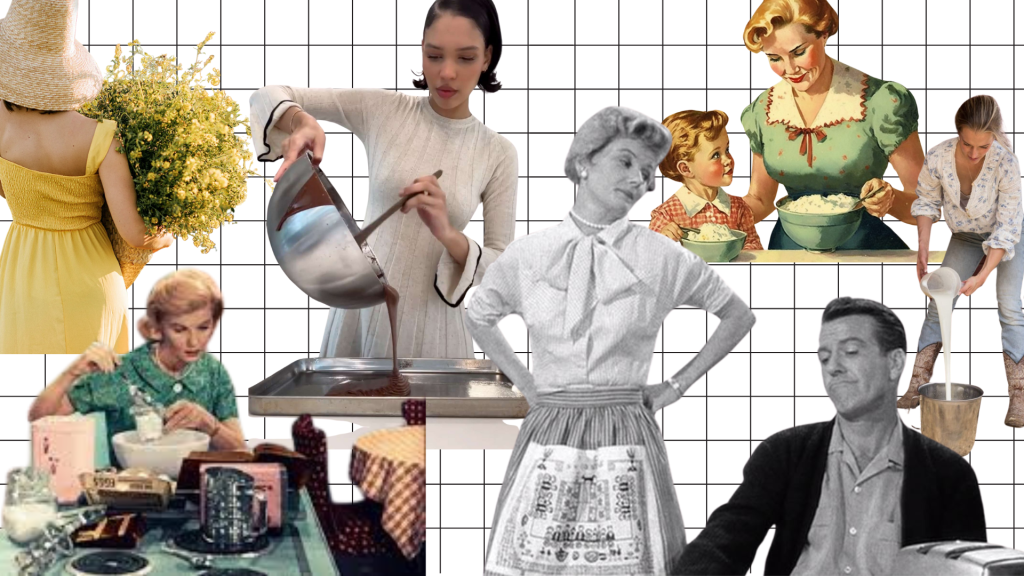In recent years, the term tradwife has gained traction on social media, referring to women who embrace a traditional housewife role characterised by staying home, caring for children, and often prioritising their husbands’ needs. With nearly 58,000 Instagram posts tagged #tradwife and over a million tagged #trad, the trend taps into nostalgia for domestic femininity. But beyond this vintage aesthetic lies a more complex discourse about gender, economics, and empowerment.
This resurgence raises questions: Are these choices empowering acts of autonomy or regressive returns to patriarchal norms? And how do they fit within a broader feminist framework?
The economics of domestic labour
Feminist scholars have long highlighted the undervaluation of domestic work. Economically invisible yet vital, unpaid housework constitutes a significant portion of societal productivity. In the UK, it was estimated in 2016 that household labor accounted for 63% of GDP when monetised. Despite this massive contribution, domestic work lacks economic recognition, resulting in its diminished societal value.
Feminist scholars have long highlighted the undervaluation of domestic work. Economically invisible yet vital, unpaid housework constitutes a significant portion of societal productivity. Women globally spend three to six hours a day on unpaid labor, while men contribute only 30 minutes to two hours (OECD). Despite this disparity, domestic work often goes unrecognised in economic calculations.
In many countries, the unequal burden of unpaid labor even directly affects women’s participation in the workforce. Studies suggest that reducing women’s unpaid workload could significantly boost economic growth; for example, the ILO estimates that a 1% increase in female employment raises GDP growth by 0.16%.
Tradwife influencers, though advocating for a retreat from paid employment, paradoxically monetise their homemaking content through brand partnerships, sponsored posts, and even high-paying influencer deals.
Burnout and modern feminism
Many tradwives argue that their choice stems from exhaustion with the dual pressures of balancing careers and family life. The pandemic exacerbated this stress, exposing the caregiving crisis and the logistical chaos American mothers face in juggling work and childcare. The notion of “having it all” began to seem less aspirational and more like an unattainable burden.
Yet this choice, however valid on an individual level, highlights deeper structural issues. With limited affordable childcare, persistent wage gaps, and a lack of paid family leave, stepping back from paid work can be seen not as liberation but as a band-aid solution to larger systemic failures.
Empowerment or patriarchal nostalgia?
The tradwife resurgence invites reflection on whether retreating to traditional roles can genuinely be empowering. Proponents claim that submitting to traditional ideals is a choice, while detractors argue that framing subservience as self-sacrifice merely perpetuates patriarchal power structures.
Historically, women’s submission was codified in legal doctrines of coverture, which erased their individual rights under the guise of protection by husbands. While tradwives today have legal autonomy, the romanticisation of submission echoes a past where women’s happiness was contingent upon serving their husbands.
Intersectionality and privilege
The tradwife movement often appeals to upper middle-class and affluent women—those who can afford to romanticise homemaking. Unlike many women who face systemic barriers to workforce participation, tradwives typically possess marketable skills, educational backgrounds, and socioeconomic advantages that allow them to choose a life centered on unpaid labor.
In contrast, women in communities where sexist norms and limited access to education restrict economic independence have far fewer choices. The World Economic Forum estimates that women globally work longer hours than men yet receive far less compensation, with much of their labor remaining invisible and undervalued.
This socioeconomic privilege among tradwives highlights the fundamental difference between voluntarily stepping away from paid work and being constrained to domestic roles due to systemic inequalities.
Conclusion: somewhere in-between
The tradwife movement is neither wholly empowering nor entirely regressive. It reflects a nuanced negotiation of modern pressures and traditional ideals, revealing both personal agency and societal constraints.
Feminism, at its core, advocates for choice—but choices exist within social, economic, and cultural contexts that shape their meaning. The tradwife trend highlights the importance of addressing systemic issues like the caregiving crisis, wage inequality, and the undervaluation of domestic work.


